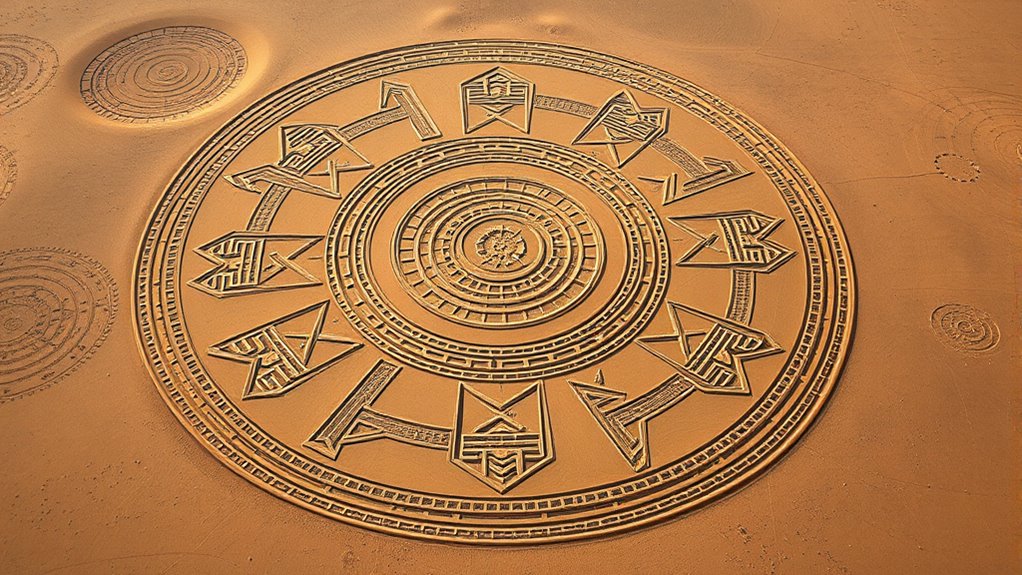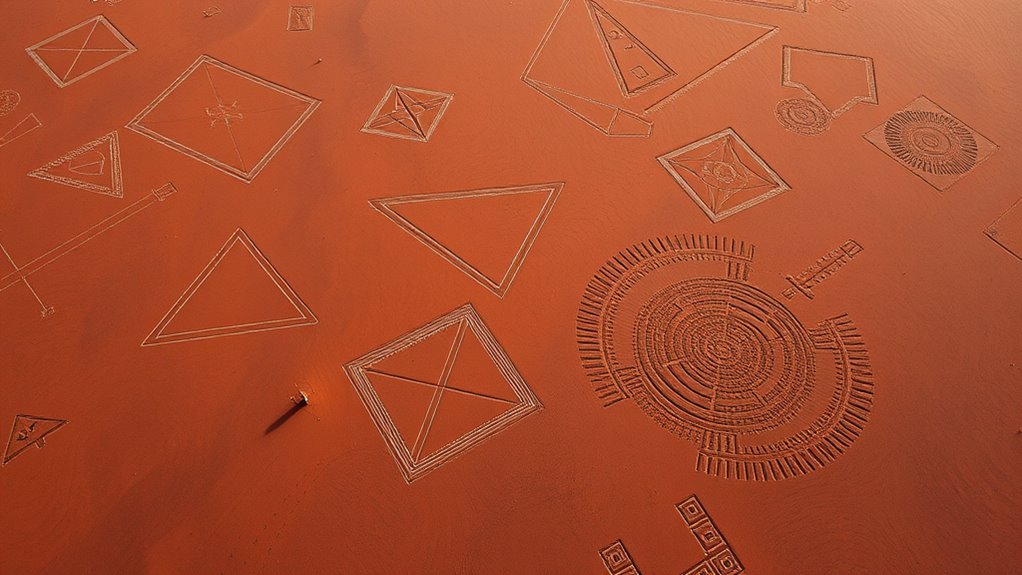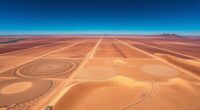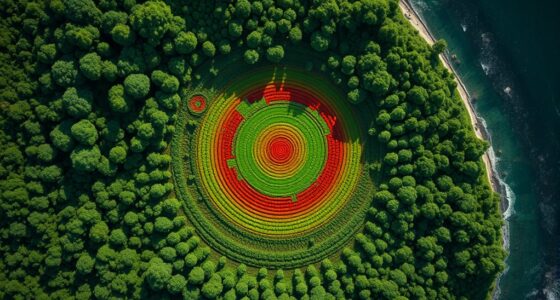Recent drone surveys reveal that the Nazca Lines are carefully designed with deliberate geometric patterns and astronomical alignments. These high-resolution images show that the ancient creators planned intricate shapes, suggesting they had advanced knowledge of measurement and celestial events. The lines may have served as an astronomical calendar or spiritual symbols, reflecting the sophistication of the Nazca civilization. To uncover more about these fascinating discoveries and what they mean, keep exploring the extraordinary secrets of the Nazca Lines.
Key Takeaways
- Drone surveys uncover detailed geometric patterns and precise alignments in the Nazca Lines, confirming their deliberate design.
- High-resolution aerial images reveal complex networks and connections among different geoglyphs.
- Recent surveys identify astronomical and geographic alignments, suggesting purposeful placement related to celestial events.
- Drone technology enhances mapping and preservation efforts by pinpointing erosion-prone and vulnerable areas.
- Findings support theories that the geoglyphs served ritual, astronomical, or symbolic functions in Nazca culture.

The Nazca Lines are a series of enormous geoglyphs etched into the desert floor of southern Peru, and they continue to fascinate researchers and visitors alike. For centuries, these mysterious shapes have puzzled archaeologists, who wonder about their purpose and significance. Thanks to recent drone surveys, you can now see how advanced aerial archaeology has uncovered new insights into these ancient mysteries. The strategic use of drone technology allows researchers to capture high-resolution images from above, revealing intricate details that were previously hidden or difficult to interpret from the ground. These surveys have demonstrated that the Nazca Lines aren’t just random designs but are meticulously planned, with geometric patterns and figures that seem to follow specific alignments.
Drone surveys reveal the Nazca Lines’ intricate, deliberate designs and possible astronomical connections.
By flying over the desert, you notice how the lines form precise shapes—straight lines, spirals, trapezoids, and circles—that suggest a deliberate purpose. The geometry isn’t accidental; it’s carefully constructed, indicating that the creators possessed advanced knowledge of measurement and spatial planning. The recent drone imagery confirms that many of these figures align with astronomical events or geographic features, hinting at a possible connection to celestial observations or ritual practices. This alignment supports the theory that the Nazca Lines served as an astronomical calendar or held spiritual significance for the ancient Nazca people. Additionally, the use of aerial survey technology has been instrumental in revealing the full extent of the geoglyphs and their complex interconnections.
Aerial archaeology has transformed how you view these geoglyphs. Instead of relying solely on ground-based exploration, you now see a landscape designed with purpose, where each line and figure contributes to a larger, meaningful pattern. The drone surveys have identified previously unknown geoglyphs and clarified the relationships between different shapes, revealing a complex network of symbols that likely played a role in religious or ceremonial activities. The clarity these surveys provide also helps preserve the site, guiding conservation efforts by pinpointing areas most vulnerable to erosion or human interference.
Ultimately, the latest drone surveys underscore the sophistication of the Nazca civilization, challenging earlier ideas that these geoglyphs were merely decorative. Instead, you’re encouraged to see them as a carefully constructed symbolic system rooted in ancient mysteries. The combination of aerial archaeology and modern technology allows you to appreciate the intentionality behind these enormous designs, deepening the understanding of their cultural and historical context. As new data emerges, you realize that the Nazca Lines continue to reveal secrets about ancient peoples’ knowledge, beliefs, and connection to the cosmos—an extraordinary testament to human ingenuity etched into the desert floor.
Frequently Asked Questions
How Old Are the Nazca Lines?
You might wonder how old the Nazca Lines are. These ancient constructions date back around 2,000 to 2,500 years, making them a fascinating archaeological site. Their age highlights their importance in understanding ancient cultures and their beliefs. The lines’ precise and purposeful geometry suggests they held significant meaning. You can appreciate their archaeological significance by studying their history, craftsmanship, and possible functions in ancient rituals or astronomy.
Are There Any New Nazca Lines Discoveries?
You might find it fascinating that recent aerial archaeology has uncovered new geoglyph patterns in the Nazca desert. While no entirely new Nazca Lines have been confirmed, advanced drone surveys continue to reveal subtle, previously unnoticed features. These discoveries deepen our understanding of the site’s complexity and purpose. With each survey, you see how modern technology helps decode ancient mysteries, uncovering fresh insights about these intricate geoglyphs.
What Materials Were Used to Create the Lines?
You wonder what materials were used in the ancient construction of the Nazca Lines. Researchers have found that the creators removed the reddish-brown iron oxide-coated stones to reveal the lighter-colored soil beneath, forming the lines. The mineral composition of these stones and soil helped preserve the designs over centuries. This simple yet effective technique highlights their understanding of local materials, ensuring the lines’ longevity.
Can the Lines Be Seen From Space?
Did you know the Nazca Lines span over 1,000 feet in some cases? From space observation, these incredible geoglyphs are visible due to their massive size, but their aerial visibility is more apparent than from orbit. You can’t see the intricate details from space, but the general shapes and lines are distinguishable. So, while you need a good aerial view, they’re not entirely clear to see from space.
Are There Any Religious or Cultural Meanings Behind the Shapes?
You might wonder if the shapes have religious or cultural meanings. Evidence suggests that the Nazca Lines are linked to ancient rituals and may align with astronomical events. These geoglyphs could have served spiritual purposes, guiding ceremonies or worship practices. Their precise layouts imply intentional design, supporting the idea that they held significant cultural and religious importance for the Nazca people, possibly connecting their rituals with celestial phenomena.
Conclusion
Just as a master painter reveals hidden strokes with each new brush, these drone surveys uncover the secrets behind the Nazca Lines’ purposeful geometry. Like a puzzle slowly coming into focus, each line and shape hints at a story waiting to be fully understood. You’re invited to see these ancient designs not just as mysterious figures, but as a timeless dialogue between humans and the sky—an enduring message etched across history’s canvas.









